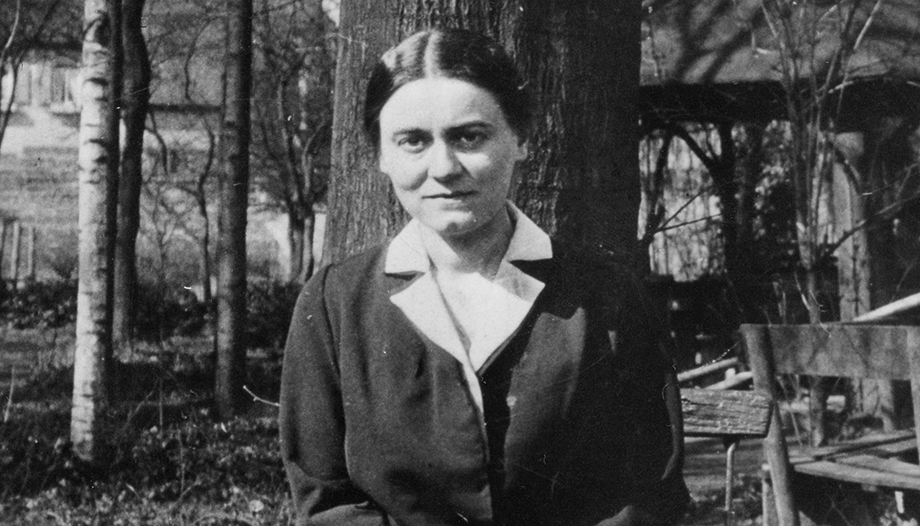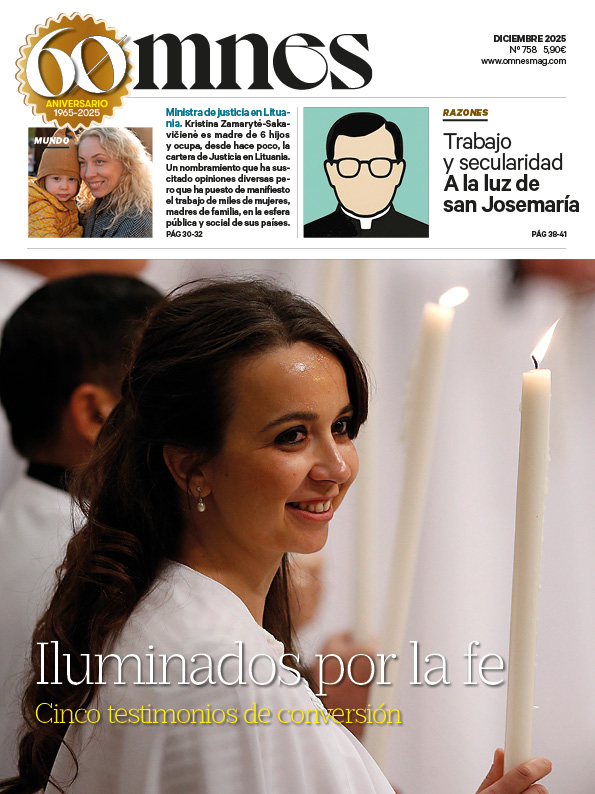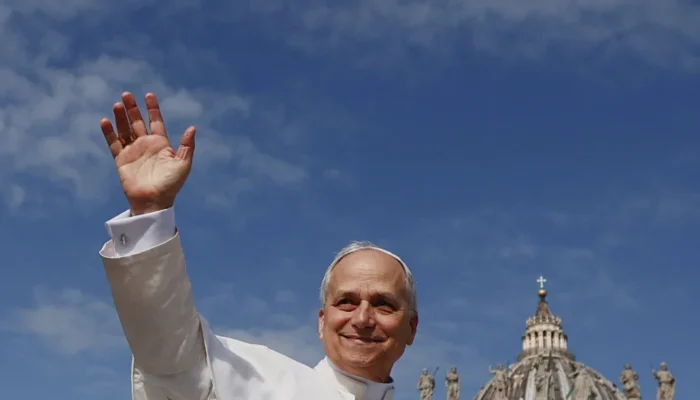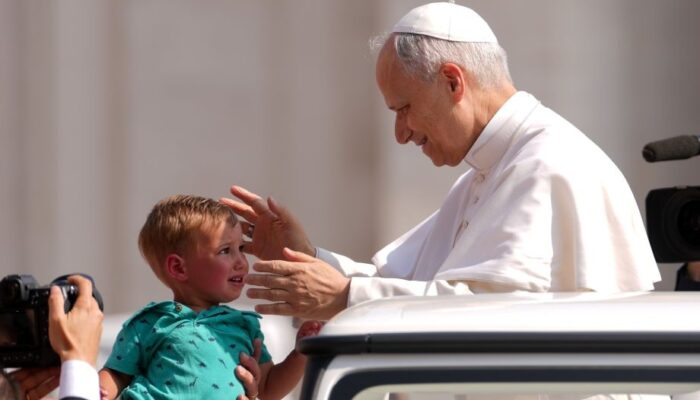Edith Stein (1891-1942) was the youngest child in a Jewish family of eleven siblings (although two died very young). Her father died when she was barely two years old (1893). And her mother, a real character, managed the family by running the sawmill they had in Breslau (today Wroclav, in Poland).
He tells the story in his autobiography, entitled About the life of a Jewish familytranslated into Spanish by Yellow stars. The book, besides the personal, wanted to show what a German Jewish family was like, when it was being challenged by the Nazi ascendancy (1933-1935).
Of his education, it is enough to highlight his precociousness and his good grades in childhood and youth. And an existential crisis, when he was 15 years old, which kept him away from his studies for almost a year. Then came the illusion of studying Germanic philology and philosophy, beginning in Breslau (1911-1912).
Edith Stein in the phenomenological movement
Having heard of Husserl's new philosophy in Göttingen, he moved there (through his mother's generosity). He participated in the so-called Göttingen Circle (1912-1917), of Husserl's first disciples, around his assistant, Von Reinach. He and his wife were close friends of Edith, as were other members, such as Romann Ingarden (who pretended to her), the Conrad-Martius couple, and Max Scheler, who was seen there and had a great influence on her.
When Husserl moved to Freiburg, she accompanied him, presented her thesis on empathy (1917) and was appointed Husserl's assistant (1917-1918). This allowed Husserl to edit the second volume of his Logical investigations and other important texts. There she met Heidegger (1889-1976), also incorporated as Husserl's assistant (but on scholarship). She was impressed by his ability, although she also noticed how he was moving away from the Christian faith, just as she was approaching it. Edith was baptized in 1922. Heidegger, who had been a seminarian (1903-1911) and enjoyed grants for training in Christian philosophy (1910-1916), married Elfride, a Protestant, in 1917; he did not baptize his first child in 1919; and he began to acquire fame and to associate with some female students (Elisabeth Blochmann, Hannah Arendt).
Edith, after collaborating for five years in phenomenological research and writing some articles (1917-1922), saw that she was not going to have a place in university teaching. Husserl did not dare to propose it and Heidegger gave her to understand that she had no future. He went on to teach at a Catholic college in Speyer (1922-1932). And he had the opportunity to teach anthropology a course in a Catholic university teaching institute (1932-1933). This is the origin of his book on The structure of the human person.
The rise of the Nazis to power (1933) prevented him from continuing to teach and he then realized his old aspiration of entering the Carmelite monastery in Cologne. There he finished, out of obedience, his great book on metaphysics, Finite and eternal being (1936). Transferred to the Carmel of Echt in Holland, she was finally imprisoned and died in the extermination camp of Auschwitztogether with her sister Rosa (1942). She was canonized as a martyr by John Paul II in 1998.
Thomistic formation
Edith Stein was a person with very serious intellectual foundations, already from her early training, and developed in the context of the intellectual rigor with which subjects were treated among the first disciples of Husserl, with a great capacity for observation.
The day after his conversion, reading the life of St. Teresa, he bought a Missal and a Catechism. And then he rigorously studied Christian doctrine and theology. Under the guidance of Erick Przywara, he was introduced to St. Thomas, studying on the one hand the Thomistic manuals (Gredt) and, on the other hand, directly to St. Thomas, especially the De Veritate and the De ente et essentia.
From De veritate published a translation and commentary. And about the De ente essentia prepared a study dedicated to Act and powerwhich he did not publish, but which would later be recast in the first chapter of Finite and eternal being.
It should be borne in mind that outside the booklet De ente et essentiaSt. Thomas did not publish systematic works of philosophy, but commented, one by one, on the works of Aristotle. The Summa Theologica and the Suma vs. GentilesThe "Thomistic philosophy", however, contained systematic philosophical developments on the relationship between God and creatures and on human action and the virtues. But the rest of "Thomistic philosophy" was composed, from the sixteenth century onwards, of the manuals ad mentem sancti Thomaeaccording to the mind of St. Thomas. Constituting a doctrine based on Aristotle with touches of St. Thomas and of the Thomistic tradition itself, with limits difficult to establish; and which was presented as an autonomous body with respect to the rest of philosophy.
The interest of Edith Stein's work is that, coming from outside, with a phenomenological formation, she is forced to review in depth the fundamental concepts, turning to the works of Aristotle and St. Thomas. And, on the other hand, she does not feel obliged to follow the traditions of the Thomistic school, among other things because they do not always correspond to the thought of St. Thomas himself. She explains this with an admirable modesty, at the beginning of Finite and eternal being.
He also then manifests the debt he owes to Przywara himself, who was then writing what would become his most famous work, Entis Analogy. The analogy of being is one of the great configuring principles of Catholic philosophy and theology. A consequence of creation that originates a scale of being with a dependence on the Creator. A world that comes from above. And it leads St. Thomas to establish the happy distinction between being and essence, which provides, at the same time, the status of creatures, with a participated being, and a new definition of God as the one whose essence is being (Ipsum esse subsistens). Przywara also introduced him to Newman, and with him he prepared a selection of texts.
Finite and eternal being
It could be said that Finite and eternal being is an essay on metaphysics with a conscientious review of the great classical themes of the Aristotelicotomist tradition: the sense of being (I), the distinction between act and potency (II), the distinction between essence and being (III), the notion and senses of substance and the concepts of matter and form (IV), the transcendentals of being (V), and the types of being and the degrees of analogy of being (VI). To which two chapters are added: the first one dedicated to the person (human and angelic) as a reflection of the Trinity (VII), with an extensive treatment of the soul; and the principle of individuation applied to persons (VIII).
Comparing this scheme with that of a classic manual of metaphysics, it is observed that all the important topics are present, except causality (the famous four causes of Aristotle) and that accidents are mentioned in passing when dealing very broadly with substance. The two topics (causality and accidents), by the way, need a revision from a modern philosophy of nature. On the other hand, the treatment of the person as individual substance is reinforced, with new perspectives taken from the Trinity. And the question of individuality (the principle of individuation) is also revised, with a more nuanced application to the person. This brings us closer to what Duns Scotus and the Victorians proposed. Edith Stein echoes the discussion. It has been said that, for the early Greeks, the first referent of being is things (stones), and that for Aristotle it is rather animals. For Christians, beings are, above all, persons, the focal point of metaphysics.
In making references to creation and the Trinity, the relationship between faith and philosophy is raised. Philosophy is based on reason. However, reason does not function in the same way when it knows Christian ideas as when it does not. In the first Christian centuries, the philosophical notion of God as a creator, personal, unique and good being was imposed as an almost self-evident notion (of reason): If God exists, he cannot be otherwise. But this notion did not exist before Christianity. Knowing that God is triune also adds a perspective on the human spirit and on the constitution of all reality. It is an inspiration that comes from revelation, but which is in harmony with the human experience of the personal world. The fields of knowledge and their methods should not be mixed, but the light of faith illuminates essential aspects of human knowledge.
The structure of the human person
Precisely insofar as ontology is centered on persons (men and angels, and on God himself), Edith Stein's metaphysics (and that of St. Thomas) is profoundly personalistic. And, for that reason, it is very well completed with The structure of the human personthe course that Edith Stein composed in 1933, while the Nazis were seizing power in Germany.
In this book, there is a clear echo of the contributions of Max Scheler, in Man's place in the cosmos (1928), which Guardini would also include in World and person. In order to situate the philosophical knowledge of man in the whole of the knowledge of reality and to connect with modern sciences, Scheler studied the strata of being. The bodies, the living beings (organic); the animals with their instinctive psychology; the human being with his self-consciousness and the need to free himself from instinctive behavior. There appears the scale of essential properties observed in nature, which is also the scale of being, ranging from bodies to persons. And, seen from God (and from the Trinity) with the analogy of being, the other way around: from God to things.
Parallel lives
In developing these ideas about metaphysics, the parallels of Edith Stein and Martin Heidegger become clearer. For many, modern metaphysics is eminently represented by Heidegger. Heidegger himself did not shy away from saying that there had been a "forgetting of being" from the pre-Socratics to himself. Thus, from his point of view, in fact, he would be the only metaphysician. There he put into play the meanings of being, also taking the human person, thrown into existence, as the main referent.
We have already mentioned the temporal coincidences: while Edith Stein was converting and acquiring a Christian thought, approaching St. Thomas (and Scotus), Martin Heidegger was moving away from faith, breaking with his scholastic studies and composing an atheistic existentialist thought. Heidegger had done his thesis on Duns Scotus, and, by entering the university (and separating himself from Christianity) he settled in a virgin terrain: the metaphysics of the pre-Socratics, recently compiled (Diels) and little studied, among other things, because very few texts have been preserved. This gave him originality and freedom, which he exploited with the poetic and teaching (and abstruse) talent that characterized him. In 1927 he published Being and timehis best known work.
The influence of Nietzsche led him to atheistic existentialism. But the influence of Hegel, which he studied in those years, led him to philosophical Nazism. It is known that in the thirties, in his courses in Freiburg, Heidegger interpreted Being and time referring to the Hegelian being that is made in history, to the spirit of the culture of the peoples; in his case, of the German people, united by the will of the Führer. This was already pointed out by his Jewish disciple Karl Löwitz, and it is demonstrated by the studies of Farias and Faye on the students' notes. Moreover, it is reflected in his famous rector's speech (1933) and in a veiled way in his Introduction to metaphysics (1935).
In part, Edith Stein's concern to develop and publish her metaphysics was to contrast the atheistic effect of Heidegger. In fact, Finite and eternal being had a last part that was the critique of Heidegger's book, but then he separated it to publish it separately. In Spanish it has been published with other criticisms of Stein to two writings of Heidegger in 1929: Kant and the Problem of Metaphysics and the inaugural lecture What is metaphysics. Edith Stein points out again and again how Heidegger does not end up drawing the consequences of what he says and closes the roads that lead from being to its cause, which is God, the first being.
For the curious tics and vagaries of cultural life, Being and timeThe book, also protected by its incomprehensibility and abstracted from its historical circumstances, became a cult book of the cultural left (and of many Christians) from the 1940s until now. While Finite and eternal beingwhich had been rescued almost miraculously from the rubble of the Carmel of Cologne, destroyed by the allied bombs, was published as best it could in 1950, and is little known. The matter deserves some reflection.








